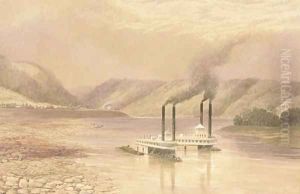Lefevre James Cranstone Paintings
Lefevre James Cranstone was a British painter born in 1822 in Henley-on-Thames, Oxfordshire, England. He was known for his watercolor landscapes and genre scenes. Cranstone's work often reflected his interest in the rural countryside and the everyday lives of its inhabitants. His style was characterized by a delicate touch and a keen eye for detail, typical of the Victorian era's watercolorists.
Cranstone's artistic journey began with his education at the Birmingham School of Design, after which he continued to develop his skills and refine his technique. Throughout his career, he exhibited at prestigious institutions such as the Royal Academy and the British Institution. Despite his presence in these notable venues, Cranstone was not as widely recognized as some of his contemporaries.
In the 1850s, Lefevre James Cranstone traveled to the United States, where he spent several years capturing the American scenery and society. His American sojourn included time in Virginia and Pennsylvania, where he painted a variety of subjects, from the natural beauty of the landscapes to the bustling life in the cities. These works are particularly valued for their historical depiction of pre-Civil War America.
Cranstone's life was not just limited to his art; he was also involved in the family business of manufacturing floorcloth and later linoleum, which was quite prominent at the time. Despite his commercial obligations, he continued to paint and exhibit his works.
Lefevre James Cranstone passed away in 1893. Today, his paintings are held in various collections, including those of museums and private collectors. They serve as a testament to his skill as a watercolorist and provide a valuable visual record of 19th-century landscapes and social history.
